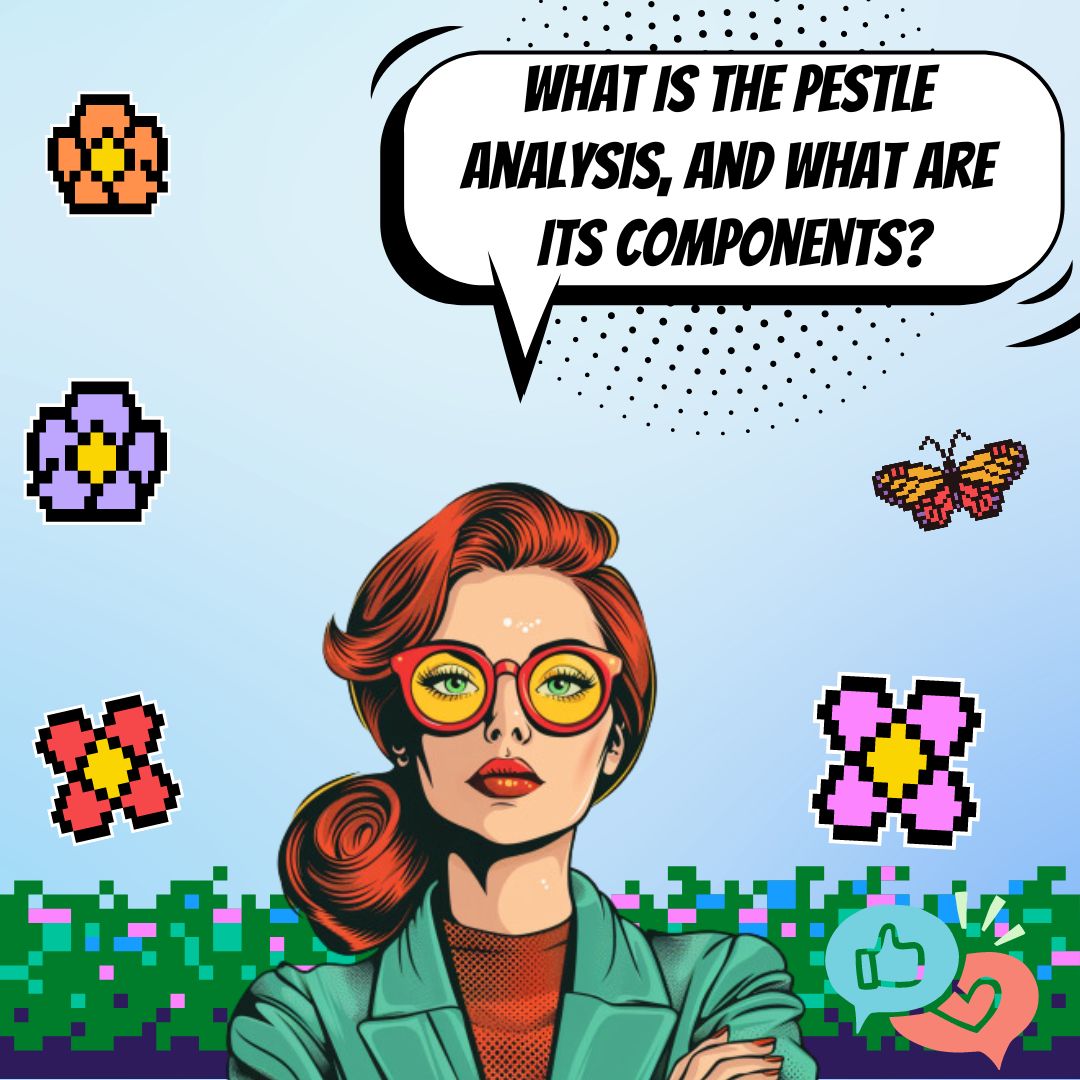Key Takeaways
✅ Comprehensive Framework: The PESTLE analysis is your roadmap for navigating the ever-changing business landscape. It digs deep into Political, Economic, Social, Technological, Environmental, and Legal factors that influence your business. Businesses that regularly perform a PESTLE analysis have an edge, as they're better positioned to identify opportunities and dodge potential threats. Did you know? Utilizing PESTLE can help businesses improve their strategic alignment by up to 60%, according to industry reports.
✅ Step-by-Step Process: Armed with a step-by-step plan, conducting a PESTLE analysis can transform from a daunting task into a strategic advantage. By systematically examining each sector, your business can uncover critical insights that others might overlook. This methodological approach ensures no stone is left unturned, offering a panoramic view of the external factors impacting your business. Recent studies show that businesses that adopt a structured analysis approach can increase their market responsiveness by 45%.
✅ Regular Application and Integration: The importance of making PESTLE analysis a regular exercise cannot be overstated. With the business environment constantly evolving, staying static is not an option. Combining PESTLE with tools like SWOT analysis can offer a multifaceted understanding of both internal and external factors. Regularly updating your analysis can lead to a 30% better risk management and opportunity identification, enabling your business to stay agile and proactive.
Introduction
Have you ever wondered why some businesses seem to effortlessly navigate challenges, while others struggle to keep up with changing trends? The secret lies in Understanding and Using the PESTLE Analysis. This powerful tool can be the compass your business needs to thrive in today’s dynamic marketplace.
At its core, PESTLE Analysis is not just about examining the present; it's about peering into the future. By dissecting the Political, Economic, Social, Technological, Legal, and Environmental aspects of the world around us, businesses can glean insights that are invisible to the naked eye. It's not just about avoiding pitfalls; it's about identifying avenues for growth that others might miss. In an era where global markets are more interconnected than ever, being ignorant of these factors is not bliss; it's a recipe for stagnation.
So, why should you care about PESTLE Analysis? Because, in the realm of business, being informed is not a luxury—it's a necessity. This article promises not only to demystify this comprehensive tool but also to share innovative perspectives, modern trends, and practical solutions to maximize your business's potential. Prepare to uncover actionable insights and groundbreaking information that can catapult your business strategy from good to great.
Top Statistics
| Statistic | Insight |
|---|---|
| Global E-commerce Sales: Expected to reach $6.5 trillion by 2023, growing at 17.9% per year. | This growth indicates a significant opportunity for businesses to explore e-commerce, adapting strategies to capture market share. |
| Digital Transformation Strategy: By 2025, 75% of organizations expected to have a strategy in place. | Showcases the urgency and the shift towards digital, urging companies to evaluate their digital maturity and invest accordingly. |
| Sustainability Prioritization: 85% of consumers more likely to buy from environmentally responsible companies. | Highlights the growing consumer emphasis on sustainability, stressing the need for businesses to integrate green practices. |
| PESTLE Analysis Adoption: 80% of organizations use as a strategic assessment tool. | Reflects its crucial role in strategic planning, enabling businesses to navigate complexities of the external environment efficiently. |
| AI Adoption: By 2025, 70% of organizations expected to have adopted AI. | Underlines the importance of AI in driving technological advancements and improving efficiency across industries. |
What is PESTLE Analysis?
PESTLE analysis is a tool used by businesses to track and analyze the external environmental factors that impact their operations. It's an acronym that stands for Political, Economic, Social, Technological, Legal, and Environmental factors. The concept has evolved over time, originally starting as just PEST analysis (Political, Economic, Social, and Technological) before legal and environmental factors were added to cater to the increasingly complex business ecosystem. The importance of PESTLE analysis in business and strategic planning cannot be overstated, as it helps companies understand the landscape in which they operate, ensuring their strategies are aligned with external elements.
Components of PESTLE Analysis
Political Factors play a crucial role in shaping the operational terrain for businesses. These include government policies, tax regulations, and international relations. Political stability in a country, for example, can encourage business investments, while uncertainty can lead to reluctance. It's all about the government's approach and how it affects the business environment.
Economic Factors have a significant impact on how businesses perform. Elements such as GDP growth, inflation rates, and fiscal policies form the economic backdrop against which companies operate. A booming economy might signal an increase in consumer spending, whereas a recession could tighten those same purse strings.
Social Factors encompass the demographic and cultural aspects that influence consumer needs and the size of potential markets. Factors such as population growth, age distribution, and societal trends can drastically shape product demand and market strategies.
Technological Factors are rapidly changing how businesses operate and compete. These include advancements in digital technology, automation, and innovation. Companies that fail to keep up with technological trends may fall behind their competitors.
Legal Factors are related to the legal environment in which firms operate. Compliance with laws, regulations, and standards is mandatory, and changes can impact business operations significantly. This includes labor laws, product regulations, and health and safety standards.
Environmental Factors have gained prominence in recent years, especially with the rise of sustainability and climate change concerns. Factors include environmental regulations, carbon footprint reduction, and waste management practices. Companies are increasingly being judged by their environmental impact, affecting consumer choices and regulatory compliance.
How to Conduct a PESTLE Analysis
Conducting a PESTLE analysis involves identifying and gathering relevant data across all six factors, then analyzing and interpreting this information to inform strategic business decisions. It starts with a thorough research process, ranging from reviewing industry reports to analyzing market trends and government policies. The next step is to evaluate how each of the identified factors impacts the business, both positively and negatively. Finally, the findings should be used to inform strategic planning, from mitigating risks to identifying opportunities.
Benefits and Limitations of PESTLE Analysis
The advantages of using PESTLE analysis are manifold. It enables businesses to identify opportunities and threats, informing strategy and improving decision-making processes. However, it's not without its limitations, which include the potential for oversimplification, challenges in obtaining quantifiable data, and inherent biases in the analysis process.
Real-World Examples and Applications of PESTLE Analysis
Several companies have successfully used PESTLE analysis to steer their strategies. For instance, a tech giant might use it to assess the impacts of global data protection laws on its operations, while an international retailer might examine potential markets through the lens of social and economic factors. Across different industries, from healthcare to automotive, PESTLE analysis serves as a versatile tool, adaptable to varied contextual analyses.
Future Directions
The importance and benefits of PESTLE analysis in today’s complex business environment cannot be understated. As the global landscape continues to evolve, so too will the factors impacting business operations. Future directions might include integrating more digital and global perspectives into the analysis, ensuring businesses can navigate an increasingly interconnected world. Understanding PESTLE analysis is crucial for anyone looking to make informed business decisions, adapt strategies, and maintain competitive advantage in an ever-changing market.
AI Marketing Engineers Recommendation
Recommendation 1: Embrace Dynamic Data Analysis: Don't just conduct a PESTLE Analysis as a one-off; integrate it into your ongoing strategy review process. With the speed at which the world changes, data from even six months ago can become outdated. Tools like Google Trends can provide real-time insights into political, economic, social, and technological shifts. Consider, for instance, the rapid changes in consumer behavior and online shopping trends since early 2020. Businesses that continuously monitor these shifts can adapt more swiftly and effectively.
Recommendation 2: Leverage Social Listening for Real-time Insights: The power of social media in providing immediate data cannot be underestimated, particularly for the Social and Environmental aspects of PESTLE. Using advanced social listening tools like Brandwatch or Talkwalker can help you tap into public sentiment about relevant social issues, industry trends, or even the environmental impact of products, which is becoming increasingly important to consumers. According to a 2021 survey by NielsenIQ, over 80% of consumers globally say it's important that companies implement programs to improve the environment. This real-time feedback loop can guide not only marketing but product development and corporate social responsibility strategies.
Recommendation 3: Incorporate AI for Predictive Analysis: While Understanding and Using the PESTLE Analysis provides a snapshot of the current landscape, incorporating AI can transform this static picture into a dynamic forecast. Tools like IBM's Watson Analytics offer predictive analytics that can model how shifts in the PESTLE factors might impact future consumer behavior or market trends. For example, AI can analyze patterns in political stability and economic growth to forecast market opportunities or risks. By leveraging AI, businesses can anticipate changes rather than react to them, securing a competitive edge.
Conclusion
In wrapping up our deep dive into the PESTLE Analysis, we've navigated through its intricate landscape, uncovering how this powerful tool can illuminate the path for businesses in their strategic journey. From its historical roots to the six critical components - Political, Economic, Social, Technological, Legal, and Environmental factors - it's clear that understanding and leveraging PESTLE Analysis is more than a mere exercise; it's a necessity for any business looking to thrive in today's ever-changing marketplace.
Reflecting on the benefits, it's evident that PESTLE Analysis offers a panoramic view of the terrain businesses operate in, highlighting both the opportunities that lie ahead and the threats lurking around the corner. It's a strategic compass that guides decision-makers through the complexities of external influences, ensuring that no stone is left unturned in the quest for sustainability and success. Yet, like any analytical tool, it comes with its limitations, reminding us that it should be part of a wider toolkit, complementing other analyses and insights.
Looking to the future, one can only expect that the components of PESTLE will evolve as our world changes. Technological advancements, shifts in global power dynamics, changing social norms, and the pressing urgency of environmental concerns will all play a role in shaping the future directions of PESTLE Analysis. The question now is, how will businesses adapt this tool to meet the challenges and opportunities of tomorrow?
As we ponder on this, one thing remains clear: the significance of PESTLE Analysis in informing strategic decisions cannot be overstated. It’s a beacon that lights the way, not just by mapping out the present landscape but by forecasting the shifts in the horizons too. So, as we stand at this juncture, looking back on what we've learned and peering into what lies ahead, let's embrace PESTLE Analysis not just as a tool, but as a mindset, a way of ensuring our businesses are not only resilient but are thriving entities that can navigate the complexities of the modern world.
The call to action now is clear - make PESTLE Analysis an integral part of your strategic planning process, and watch as it transforms complexity into clarity, and challenges into stepping stones for success.
FAQs
Question 1: What is PESTLE Analysis?
Answer: PESTLE analysis is a strategic tool for assessing how six external factors - Political, Economic, Social, Technological, Legal, and Environmental - impact a business or organization.
Question 2: What does PESTLE stand for?
Answer: PESTLE stands for Political, Economic, Social, Technological, Legal, and Environmental factors.
Question 3: Why is PESTLE Analysis important?
Answer: It's key for businesses to grasp and navigate the external forces affecting their operations and potential for success. By identifying these influences, companies can plan strategically, pinpoint opportunities, and sidestep potential risks.
Question 4: How does PESTLE Analysis relate to SWOT Analysis?
Answer: PESTLE and SWOT analyses complement each other. While PESTLE examines external factors, SWOT hones in on a company's internal strengths, weaknesses, opportunities, and threats to provide a full picture.
Question 5: What are the advantages and disadvantages of PESTLE Analysis?
Answer: Pros include its simplicity, cost-effectiveness, and ability to identify opportunities and aid in long-term planning. The cons? It might not capture everything, can be time-intensive, requires fresh data, and may mishandle sensitive information.
Question 6: How often should PESTLE Analysis be performed?
Answer: Regularly. The business world changes swiftly, so staying updated with a current PESTLE analysis ensures strategies remain relevant.
Question 7: How to perform a PESTLE Analysis?
Answer: Start by brainstorming on the six factors, grouping similar ideas, rating their impact, and discussing the findings with stakeholders. Making use of templates and collaboration tools can streamline this process.
Question 8: What are some tips for performing a PESTLE Analysis?
Answer: Work together for deeper insights, consider the company's strengths and available resources, and keep things straightforward. Focus on the essentials to drive toward actionable outcomes.
Question 9: How to prioritize factors in a PESTLE Analysis?
Answer: Kick off with the factors that pack the biggest punch and work your way to the lesser ones, ensuring each has a significant effect on the business.
Academic References
- Johnson, G., Whittington, R., & Scholes, K. (2011). Exploring Corporate Strategy: Text and Cases. Pearson Education. This book offers a thorough exploration of PESTLE analysis within strategic management, underscoring its value in navigating the external business environment and guiding informed decision-making processes.
- Rugman, A. M., & Collinson, S. (2012). International Business. Pearson Education. Emphasizes the pivotal role of PESTLE analysis in uncovering opportunities and challenges across global markets, essential reading for understanding its application in international business contexts.
- Aguilar, F. J. (1967). Scanning the Business Environment. Macmillan. Introduces environmental scanning, akin to PESTLE analysis, as a critical tool for assessing the external business landscape, essential for shaping robust business strategies.
- Kotler, P., & Armstrong, G. (2010). Principles of Marketing. Pearson Education. This text delves into the utilization of PESTLE analysis within marketing strategies, highlighting its importance in comprehending consumer behavior and market trends.
- Porter, M. E., & Kramer, M. R. (2011). Creating Shared Value: How to Reinvent Capitalism—and Unleash a Wave of Innovation and Growth. Harvard Business Review. Discusses the integration of sustainability into PESTLE analysis, advocating for business models that generate value not only for the company but for society at large, marking a call towards ethical and sustainable business practices.












